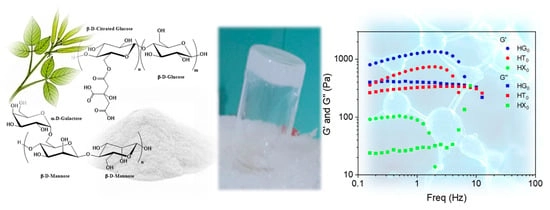- Article
Eco-Friendly Hydrogels from Natural Gums and Cellulose Citrate: Formulations and Properties
- Giuseppina Anna Corrente,
- Fabian Ernesto Arias Arias and
- Eugenia Giorno
- + 6 authors
The design of sustainable hydrogel materials with tunable mechanical and thermal properties is essential for emerging applications in flexible and wearable electronics. In this study, hydrogels based on natural gums such as Guar, Tara, and Xanthan and their composites with Cellulose Citrate were developed through a mild physical crosslinking process, ensuring environmental compatibility and structural integrity. The effect of cellulose citrate pretreatment under different alkaline conditions (0.04%, 5%, and 10% NaOH) was systematically investigated using Fourier Transform Infrared Spectroscopy (FT-IR), Thermogravimetric Analysis (TGA), and dynamic rheology. Overall, the results show that the composites exhibit different properties of the hydrogel networks compared to the pure hydrogel gums, strongly depending on the alkaline treatment. In all composite hydrogels, a significant increase in the number of interacting rheological units occurs, though the strength of the interactions decreases in Guar and Tara composites, which exhibit partial structural destabilization. In contrast, Xanthan–Cellulose Citrate hydrogels display enhanced strong gel character, and crosslinking density. These improvements reflect stronger intermolecular associations and a more compact polymer network, due to the favorable H-bonding and ionic interactions among Xanthan, Cellulose and Citrate mediated by water and sodium ions. Overall, the results demonstrate that Xanthan–Cellulose Citrate systems represent a new class of eco-friendly, mechanically robust hydrogels with controllable viscoelastic and thermal responses, features highly relevant for the next generation of flexible, self-supporting, and responsive soft materials suitable for wearable and stretchable electronic devices.
12 December 2025




